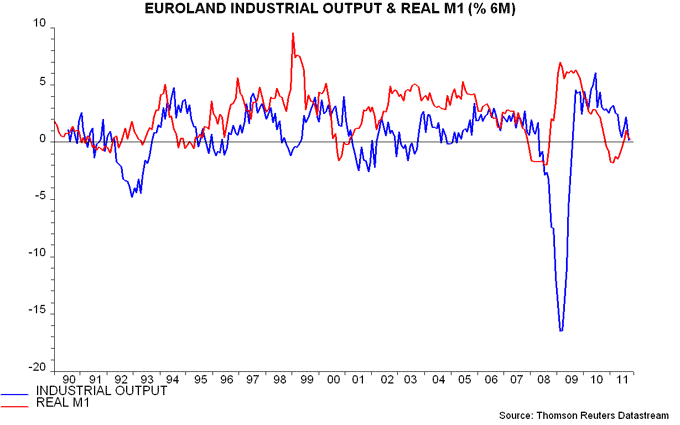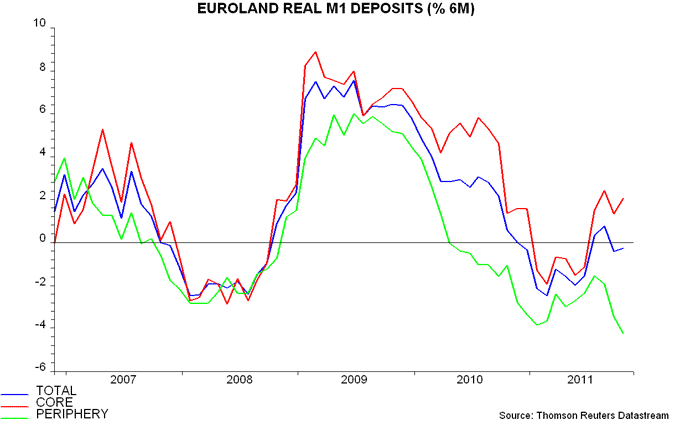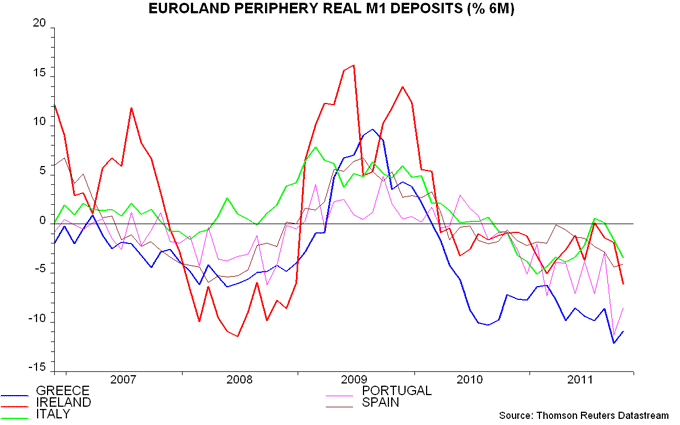Entries from November 1, 2011 - November 30, 2011
UK Autumn Statement: much ado about nothing
The vast coverage of the Autumn Statement is out of all proportion to its macroeconomic significance.
The Chancellor and the Office for Budget Responsibility (OBR) have, in effect, traded assumptions. The OBR has cut its guess about potential output, implying that a larger proportion of the current deficit is structural. The Chancellor has retaliated by assuming that he will be able to cut public spending by 0.9% a year in real terms in 2015-16 and 2016-17, thereby putting the structural budget position back on track. The various measures announced in the Statement, while possibly of merit, are too small to have a major impact on the economic and fiscal outlook.
It should be stressed that the OBR’s negative reassessment of the fiscal position reflects a downgrade to its estimates of current and future potential output rather than worse-than-expected recent borrowing outturns. This downgrade may or may not be warranted but it is troubling that the fiscal framework pivots on a concept subject to huge empirical uncertainty.
Aside from the further spending cut from 2015-16, the various measures announced in the Statement are essentially self-financing. The main short-term expansionary measures are a reduced rise in fuel duties (costing £975 million in 2012-13), an increase in infrastructure spending (£760 million), additional funding for the Youth Contract (£365 million), small business rate relief (£210 million) and a cap on rail fares (£105 million). The infrastructure boost rises to £2.145 billion by 2014-15 but this is still only 0.1% of GDP. The Chancellor, of course, hopes to tap pension funds to finance a more ambitious programme but delivery is uncertain.
The cost of these measures is met by capping child and working tax credit (raising £1.24 billion in 2012-13), changing the tax treatment of asset-backed pension contributions (£450 million), cutting overseas aid (£380 million) and raising the bank levy (£280 million).
The Chancellor took credit for the low level of gilt yields in his speech but Bank of England data released today suggest that QE2 and capital flight from the Eurozone have been the key drivers: the Bank essentially monetized the budget deficit in October, with purchases of £16.9 billion versus DMO issuance of £17.0 billion, while foreign gilt-buying surged to £12.5 billion – the highest since April 2010.
UK real money pick-up to support economy
UK monetary statistics for October suggest that widespread gloom about economic prospects is overdone.
Broad money, on the preferred M4ex measure, rose by a respectable £8.5 billion or 0.5% in October, partly reflecting Bank of England gilt purchases of £16.9 billion. This builds on an acceleration occurring before the launch of QE2: six-month growth has firmed to an annualised 4.5% with the year-on-year increase up to 2.8% – the highest since June 2009.
A broader liquidity aggregate including private sector holdings of Treasury Bills, National Savings instruments, DMO repos and foreign currency deposits at UK banks is growing more strongly than M4ex – an annual 4.1% in October.
Corporate liquidity is improving: M4 holdings of private non-financial corporations rose by an annualised 9.0% in the latest three months.
Better nominal monetary trends combined with slowing inflation will lead to a significant acceleration in real money expansion by early 2012, boosting growth later next year. The view here is that an inflation squeeze on real money was a major reason for this year’s economic weakness.
The Bank essentially monetized the budget deficit in October – bond purchases of £16.9 billion compared with DMO net issuance of £17.0 billion. Capital flight from the Eurozone continued to boost the gilt market, with overseas investors buying £12.5 billion – an 18-month high. Banks, meanwhile, purchased by £2.7 billion, with the non-bank private sector acting as “seller of last resort”, reducing holdings by £16.7 billion.
Eurozone money numbers confirm peripheral slump
Eurozone monetary statistics for October are weak but the bigger story is a widening core / periphery divergence, with an accelerating decline in real M1 deposits in the latter group suggesting that economies remain locked on course for a depression barring radical ECB action.
M1 – comprising currency in circulation and overnight deposits – is a better leading indicator than the broader M3 measure, probably because households and firms increase their holdings of more liquid forms of money before raising spending. The six-month rate of change of Eurozone-wide real M1 turned negative in late 2010, warning that a recession would develop during 2011. The six-month change has since returned to positive territory but remained weak at just 0.3% (0.5% annualised) in October – see first chart.
The ECB publishes a country breakdown of overnight deposits but not currency. Region-wide real M1 deposits fell by 0.3% in the six months to October but this conceals a 2.1% rise in core economies (i.e. Germany, France, Netherlands, Austria, Belgium, Luxembourg) offset by a record 4.2% decline (8.3% annualised) in the periphery (Italy, Spain, Greece, Portugal, Ireland) – second chart. Peripheral weakness partly reflects capital flight into the core or out of the euro area altogether but this does not alter the economic implications – money leaving M1 accounts will not be spent domestically.
The annualised fall in the six months to October was 20.7% in Greece, 16.3% in Portugal, 11.8% in Ireland, 8.1% in Spain and 6.7% in Italy. The Portuguese reading confirms that last month’s slump was no fluke while Irish and Italian numbers have deteriorated markedly since the summer, when there were tentative signs of real M1 deposits stabilising – third chart.



EMU bonds on course for worst performance since 1999
A weighted average of 7-10 year sovereign yields in 12 Eurozone markets – calculated by Datastream using debt weights – is at its highest level since 2008, having surged by 100 basis points since early September. This represents a substantial tightening of financial conditions warranting a monetary policy response ideally combining a large cut in official interest rates with country-neutral QE aimed partly at reversing the yield rise.
Commentators surprised at the euro’s resilience against the US dollar may be neglecting the extent to which bond prices have taken the strain of the crisis – the EMU-12 7-10 year bond price index has fallen by 7.9% since the early September yield low versus stability in same-maturity Treasuries (-0.1%).
Year to date, EMU bonds are down by 5.5%, representing – barring a late recovery – the worst annual performance since 1999, when 7-10 year Bunds plunged 9.6% as the newly-created ECB tightened policy at the tail-end of the technology boom.
A country-neutral QE operation – with purchases spread across national markets in proportion to GDP or population – would emphasise the monetary motivation and counter criticism of a backdoor fiscal bailout. A reasonable initial target would be buying of 5% of GDP over four months (i.e. equal to the current UK programme), implying a monthly rate of about €120 billion. For comparison, the ECB has purchased a cumulative €120 billion since its “securities markets programme” (SMP) was restarted in early August, equivalent to €35 billion per month.
Claims that such a policy would amount to inflationary money-printing should be met head on. The ECB is already conducting QE via its SMP and covered bond purchases – the SMP "sterilisation" operation involving auctioning one-week term deposits is entirely cosmetic since banks will regard such deposits as fungible with central bank reserves. More importantly, money-printing is necessary to head off deflation if the banking system is destroying deposits by accelerating deleveraging in response to sovereign bond losses and misguided regulatory pressure.


Business surveys: Chinese / Eurozone weakness vs US resilience
“Flash” PMIs for November released this morning confirm a Eurozone recession while suggesting that Chinese industrial momentum has slowed abruptly. The latter indication, however, is at odds with other recent evidence. The latest regional Fed manufacturing survey, meanwhile, echoes an improvement in optimism in other recent polls.
Asian equity markets were knocked back by release of the Markit Chinese manufacturing PMI data, showing a slump in new orders in November, reversing surprising strength in October. The Markit survey, however, sometimes diverges from the more reliable official PMI, November results for which will be released at the start of December – note the misleadingly-weak Markit new orders reading in mid 2010.

The suggestion from the Markit survey of an abrupt weakening of Chinese industrial activity sits uneasily with other recent evidence, including a firmer leading indicator and less negative company earnings revisions. 

Chinese real money trends, meanwhile, were signalling economic weakness earlier in the year but have recently started to recover.
Bottom line: the Markit results are probably erratically weak but will add to pressure for policy easing.
The Eurozone flash PMI new business indicator recovered marginally in November but remains in recession territory. The small rise was due to services with the manufacturing new orders index falling further.
Recent US manufacturing surveys, by contrast, have indicated stable current order flows and rising optimism about prospects. With three of the five regional Fed polls so far released (New York, Philadelphia and yesterday's Richmond), an average of orders outlook indices has risen to its highest level since April.
ECB support operations at new record
ECB system support rose by a further €48 billion to a new record last week. The definition of system support here covers lending in weekly and long-term repos, other claims on banks, “other assets” – incorporating the emergency liquidity assistance operations of Greece and Ireland (at least) – and sovereign and covered bond purchases.
System support has increased by €426 billion since April, equivalent to 4.5% of GDP – see previous post for more discussion.


